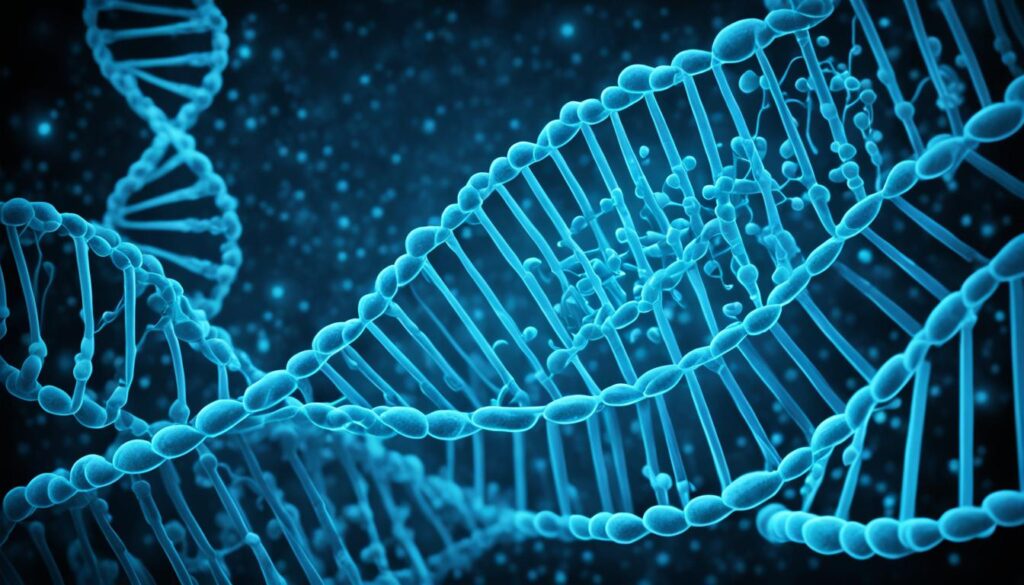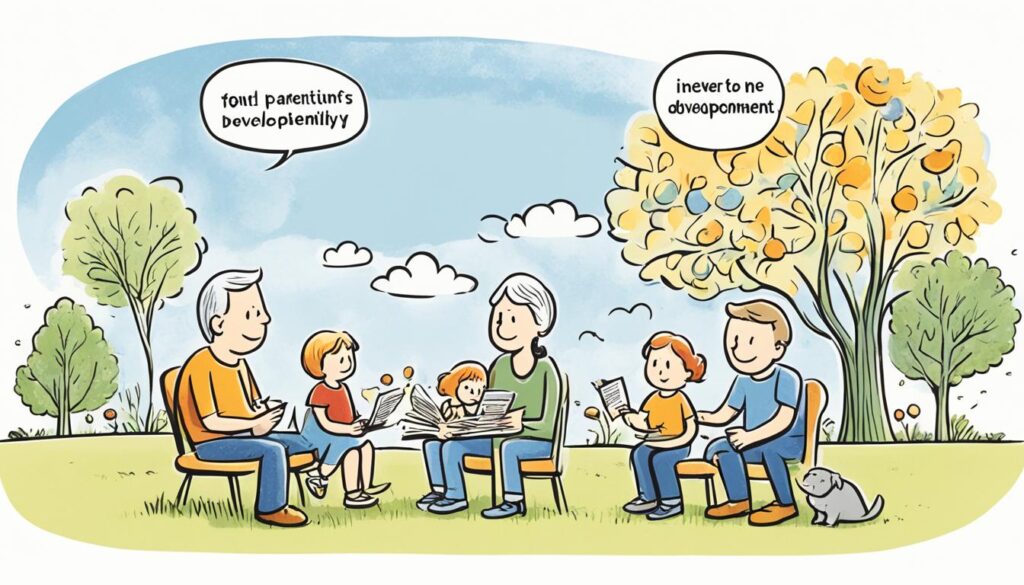Are introverts born that way? Is their preference for solitude and quiet environments simply a result of their genetics? These questions have long intrigued scientists and psychologists, and recent research is shedding light on the role genetics play in shaping introverted traits. Yes, introversion can have a genetic component. The study conducted on 225 obstetric gynecology patients using the NPA personality test found higher introversion tendencies in individuals with blood type AB compared to those with blood type O, and when comparing AB to blood type A. Given that introversion has a 50% genetic causation, these findings suggest that genetic factors could contribute to the differences in introversion tendencies observed among individuals with different blood types.
Key Takeaways:
- Introversion, characterized by a preference for solitude and internal reflection, is influenced by both genetics and environmental factors.
- Specific genes and biological mechanisms have been identified that are associated with introverted traits.
- Dopamine, serotonin, sensitivity to reward, cortisol levels, and brain structure are factors influenced by genetics that contribute to introversion.
- Peer relationships and social experiences in childhood significantly impact the development of introverted traits.
- Educational and school environments can impact the development and expression of introverted traits.
- Culture and society play a significant role in shaping the expression and acceptance of introverted traits.
1. Dopamine and neuroticism
Dopamine, a neurotransmitter known for its role in the brain’s reward and pleasure centers, has been linked to introverted traits. Individuals with lower dopamine levels tend to exhibit higher levels of introversion.
The regulation of the dopamine system is influenced by the dopamine beta hydroxylase gene. Variations in this gene can impact an individual’s dopamine levels, which in turn may contribute to introverted behaviors.
For example, imagine two individuals with different variants of the dopamine beta hydroxylase gene. The individual with the variant associated with lower dopamine levels may be more prone to introversion and neuroticism, while the other individual with a variant linked to higher dopamine levels may exhibit more extroverted traits.
| Genetic Variant | Dopamine Level | Introversion Level | Neuroticism Level |
|---|---|---|---|
| Lower dopamine variant | Low | High | High |
| Higher dopamine variant | High | Low | Low |
It’s important to note that dopamine’s impact on introversion and neuroticism is influenced by various factors, such as interactions with other neurotransmitters and environmental influences. The complex interplay between genetics, neurobiology, and the environment contributes to the diverse range of introverted traits observed in individuals.
- Dopamine, a neurotransmitter, influences introverted traits and neuroticism.
- Variations in the dopamine beta hydroxylase gene affect dopamine levels.
- Different dopamine levels can contribute to introverted or extroverted behaviors.
- The interplay between genetics, neurobiology, and the environment shapes introverted traits.
2. Serotonin transporter gene
The serotonin transporter gene, known as SLC6A4, plays a crucial role in regulating the availability of serotonin in the brain. Serotonin is a neurotransmitter that influences mood, emotion, and social behavior. Variations in the serotonin transporter gene have been associated with differences in introversion and extroversion.

Studies have suggested that individuals with certain genetic variants of the serotonin transporter gene may have a higher tendency towards introversion. The presence of these genetic variations can affect how efficiently serotonin is transported and utilized in the brain, potentially influencing an individual’s temperament and social behavior.
Research has shown that individuals with increased serotonin transporter function tend to exhibit extroverted behaviors as they’re more sociable and may be less sensitive to social stimuli. So based on this, we can say that introverts have less serotonin function as these individuals may prefer quieter and less stimulating environments, as they may become easily overwhelmed by social interactions.
Furthermore, the interplay between the serotonin transporter gene and other genetic and environmental factors can further shape the expression of introverted traits. For example, individuals with both certain genetic variants of the serotonin transporter gene and early-life stressful experiences may be more susceptible to developing introverted tendencies.
Understanding the influence of the serotonin transporter gene on introversion can provide valuable insights into the biological basis of this personality trait. It highlights the intricate relationship between genetics and behavior, shedding light on why some individuals are more inclined towards introversion.
| Genetic Variant | Characteristics |
|---|---|
| Short allele | Associated with decreased serotonin transporter function |
| Long allele | Associated with increased serotonin transporter function |
Some studies have found that individuals carrying one or two copies of the short allele of the serotonin transporter gene are more likely to exhibit introverted behaviors, such as a preference for solitude and contemplation. However, it is important to note that genetics is just one factor influencing introversion, and its impact can vary among individuals.
- Individuals with certain genetic variants of the serotonin transporter gene may have a higher tendency towards introversion.
- The presence of genetic variations in the serotonin transporter gene can affect the transport and utilization of serotonin in the brain.
- Research has shown that individuals with decreased serotonin transporter function tend to exhibit introverted behaviors and may be more sensitive to social stimuli.
- The interplay between the serotonin transporter gene and other genetic and environmental factors can further shape the expression of introverted traits.
- Understanding the influence of the serotonin transporter gene on introversion can provide valuable insights into the biological basis of this personality trait.
3. Sensitivity to reward
Sensitivity to reward plays a significant role in understanding introversion. It refers to an individual’s responsiveness to positive and rewarding stimuli. Some people are more sensitive to rewards, finding joy and motivation in high-stimulation environments, while others are less sensitive and tend to exhibit introverted behaviors, preferring low-stimulation environments.
Genetic factors, such as variations in the dopamine receptor genes, have been linked to differences in sensitivity to reward and introverted traits. The dopamine system, responsible for the brain’s reward and pleasure centers, influences an individual’s sensitivity to rewards. For example, certain genetic variations associated with lower dopamine levels may contribute to lower reward sensitivity and subsequently lead to introverted behaviors.
To better understand the genetic basis of reward sensitivity, let’s examine an example. Consider two individuals, Sarah and John. Sarah has a genetic variation that enhances dopamine receptor activity, making her more sensitive to rewards. As a result, she seeks out social interactions and thrives in vibrant, stimulating environments. On the other hand, John has a genetic variation that reduces dopamine receptor activity, making him less sensitive to rewards. He prefers quieter, less stimulating settings, and finds solace in solitary activities.
This image demonstrates the concept of sensitivity to reward and its relationship with introversion. The interplay between genetics and reward sensitivity contributes to the development of introverted traits.
4. Cortisol levels
Cortisol, a hormone released in response to stress, plays a crucial role in the body’s stress response system. Research has shown that introverts tend to have higher baseline cortisol levels compared to extroverts. This indicates that introverts may have a heightened physiological response to stress.
The regulation of cortisol levels is influenced by genetic factors, such as the corticotropin-releasing hormone receptor 1 gene. Variations in this gene may contribute to differences in cortisol regulation between introverted and extroverted individuals.
Understanding the relationship between cortisol levels and introversion provides valuable insights into the potential genetic influence on an individual’s response to stress. It suggests that introverts may be more sensitive to stressful situations, leading to elevated cortisol levels that contribute to their introverted traits.

Imagine you are an introvert attending a crowded and noisy party. The constant stimulation and social interactions may trigger your body’s stress response, resulting in increased cortisol levels. This physiological reaction can amplify your introverted tendencies, making you crave solitude and quiet environments for relief.
| Cortisol Levels | Introverts | Extroverts |
|---|---|---|
| Baseline | Higher | Lower |
| Response to Stress | Heightened | Moderate |
Key points:
- Introverts tend to have higher baseline cortisol levels.
- The corticotropin-releasing hormone receptor 1 gene may contribute to cortisol regulation.
- Introverts may exhibit a heightened physiological response to stress.
5. Brain structure
Neuroimaging studies have revealed fascinating differences in brain structure between introverts and extroverts. These structural variances provide valuable insights into the genetic foundations of introverted traits and how they are expressed through brain anatomy.
One significant finding is that introverts tend to have a thicker prefrontal cortex compared to extroverts. The prefrontal cortex is responsible for various higher-order cognitive functions, including self-reflection and decision-making processes. The increased thickness in this region suggests that introverts may have a greater capacity for introspection and deep thinking.
Conversely, extroverts may exhibit a larger volume of gray matter in brain regions associated with processing sensory information and reward. Gray matter plays a crucial role in information processing, and a larger volume in these regions implies that extroverts may have heightened sensitivity to external stimuli and a stronger response to rewards from social interactions.
These structural differences support the notion that genetics contribute to the development of introverted traits through the modulation of brain structure and function. Although more research is needed to fully understand the intricacies of this relationship, these findings showcase the fascinating interplay between genetic factors and brain anatomy in shaping introversion.
But Genetics Is Not The Only Factor – 7 Ways Environment Shapes Introverts
Are introverts made or born? While genetics certainly play a role in shaping introverted traits, the environment is equally influential in molding these personality characteristics. Upbringing, cultural influences, educational environments, health factors, socioeconomic statuses, and lifestyle choices all contribute to the development and expression of introversion. So, what are the key factors in the environment that shape introverts? Let’s explore.

1. Peer Relationships and Social Experiences in Childhood
Peer relationships and social experiences in childhood are crucial factors that significantly impact the development of introverted traits. During childhood, young introverts may face challenges in navigating social interactions and establishing close friendships.
Exposure to diverse social situations and spending quality time with peers can play a pivotal role in influencing an individual’s comfort level in social settings. It provides young introverts with opportunities for social skill development, helping them understand social dynamics and improve their ability to interact with others.
Positive experiences and supportive relationships with peers can shape an introvert’s confidence and social engagement. When young introverts feel understood and accepted by their peers, they are more likely to feel comfortable and develop a healthy sense of self within social contexts.
“Growing up, I struggled a lot with social interactions. I was always the quiet one in the group and found it challenging to initiate conversations or make friends. However, as I got older, I started fostering positive relationships with a few close friends who accepted me for who I am. These friendships provided me with the support and confidence to open up and engage in social situations more comfortably.” – Sarah, introvert
Table: Examples of Peer Relationships and Social Experiences in Childhood
| Positive Factors | Negative Factors |
|---|---|
|
|
Positive peer relationships and various social experiences shape the social development of young introverts and have a lasting impact on their ability to engage with others confidently. The journey towards becoming a self-assured and socially adept individual involves navigation of social challenges and the influence of supportive peers.
2. The Effects of Culture and Society
Culture and society have a significant impact on the expression and acceptance of introverted traits. In different cultures, introverted behaviors may be seen as more desirable or acceptable, while others may value extroversion. These cultural norms and societal expectations influence how individuals perceive their introverted traits and whether they feel accepted or disadvantaged because of their genetic predisposition. Understanding the cultural context is key to gaining insights into the experiences of introverts in different societies.
To illustrate the effects of culture and society on introversion, consider the following examples:
- In some Asian cultures, quiet and contemplative behaviors are often admired, and introversion may be associated with wisdom and intellectualism.
- In contrast, Western societies often value assertiveness, sociability, and outgoing personalities, which may place introverts at a disadvantage in certain situations.
- Certain cultures may have specific social norms that encourage more introverted behaviors, such as meditation practices or a slower-paced lifestyle.
- On the other hand, extroverted traits may be preferred in cultures that emphasize collective identities and group interactions.
The interplay of culture and society with an individual’s genetic predisposition towards introversion or extroversion shapes their experiences and self-perception. Awareness of these cultural dynamics allows for a better understanding and appreciation of the diverse expressions of introversion.

3. Educational and School Environments
Educational and school environments have a significant impact on the development and expression of introverted traits. For introverted students, overstimulating or socially demanding classroom settings can pose challenges, while quieter and more reflective learning environments may be preferred.
| Challenges in Overstimulating Environments | Support in Reflective Environments |
|---|---|
|
|
Teachers and schools that recognize and accommodate different learning styles can create a supportive environment for introverted students to excel both academically and socially. By providing opportunities for independent work, collaboration in small groups, and alternative forms of participation, schools can help introverted students thrive.
4. Health, Medical Factors, and Personality Development
Health and medical factors can significantly influence an individual’s personality development and the expression of introverted traits. Various conditions, such as anxiety, depression, or neurodevelopmental disorders, can impact an individual’s social engagement and comfort level in social situations.
Anxiety: Individuals with anxiety may experience heightened worry and fear, which can contribute to avoiding or withdrawing from social interactions. This can manifest as introverted behavior and a preference for solitude to minimize anxiety symptoms.
Depression: Depression can affect an individual’s energy levels, motivation, and overall mood. In some cases, individuals with depression may exhibit introverted behaviors as they may feel exhausted or lack the energy to engage in social activities.
Neurodevelopmental Disorders: Conditions such as autism spectrum disorder (ASD) or attention deficit hyperactivity disorder (ADHD) can influence an individual’s social interactions and communication skills. These conditions may contribute to introverted behaviors, as individuals with ASD or ADHD may find it challenging to navigate social situations or may prefer solitary activities.
It’s important to recognize and address these factors in order to support the well-being and development of introverted individuals. By providing appropriate medical care, therapy, and support, individuals can better manage their conditions and thrive in their personal and social lives.

| Medical Factors | Impact on Introversion |
|---|---|
| Anxiety | Heightened worry and avoidance of social interactions |
| Depression | Lack of energy and motivation for social activities |
| Neurodevelopmental Disorders | Challenges in social interactions and communication |
Recognizing and addressing the role of health and medical factors in shaping introverted traits can contribute to a more comprehensive understanding of introversion and facilitate appropriate support and interventions.
5. Socioeconomic Statuses and Stress Levels
Socioeconomic statuses and the associated stress levels can significantly impact how individuals express introverted traits. People from lower socioeconomic backgrounds often face economic and social stressors that can influence their comfort level in social situations. The stressors may result from financial constraints, limited access to resources, or societal pressures.
The stress experienced by individuals from lower socioeconomic backgrounds can affect their energy levels, cognitive function, and overall well-being. Higher levels of stress may lead to decreased motivation, reduced social engagement, and a preference for solitude. These factors can contribute to the development and expression of introverted traits.
To support individuals from different socioeconomic backgrounds and alleviate stress, it is crucial to establish support systems and provide resources. This could include access to mental health services, financial assistance programs, and educational opportunities. By addressing the stressors associated with lower socioeconomic statuses, we can create an environment that fosters positive social engagement and supports individuals in expressing their unique personality traits.
One way to mitigate the impact of socioeconomic stressors is by creating support groups or community programs that offer mentorship, counseling, and educational resources. These initiatives can help individuals develop coping strategies, build resilience, and enhance their overall well-being.
6. Choosing Careers and Lifestyle Paths
The choice of careers and lifestyle paths can have a profound impact on how introverted traits are expressed and experienced. For introverts, finding a career that aligns with their natural preferences can lead to increased job satisfaction and overall well-being.
Introverts tend to thrive in careers that emphasize independent work, creativity, and reflection. They often find fulfillment in roles that allow for deep focus and introspection, such as writing, research, or the arts. These professions provide introverts with the opportunity to delve into their own thoughts and ideas, utilizing their innate strengths.
Additionally, introverts often prefer a lifestyle that reflects their need for solitude and quiet. They may choose to live in quieter neighborhoods or seek out activities that align with their interests and provide a sense of peace and tranquility.
By understanding and embracing these preferences, introverts can create a career and lifestyle path that allows them to thrive. They can design their environments and daily routines to support their introverted nature, fostering a sense of well-being and fulfillment.

For example, an introvert who enjoys writing may choose a career as a freelance writer, allowing them to work independently and follow their creative pursuits. They may opt to work from a home office or a quiet coffee shop, creating an environment that fosters concentration and inspiration.
Similarly, an introvert who values tranquility may choose to live in a small town or a rural area, away from the hustle and bustle of the city. They may engage in activities like hiking, painting, or reading, which provide a sense of relaxation and fulfillment.
To summarize, choosing careers and lifestyle paths that cater to introverted preferences can enhance the well-being and satisfaction of introverts. By embracing their natural inclinations and creating environments that support their needs, introverts can lead fulfilling lives that honor their unique traits.
7. The Interplay Between Nature and Nurture
The development of introverted traits is influenced by a complex interplay between genetics and environmental factors. While genetic predispositions lay the foundation for introversion, the environment plays a crucial role in shaping how these traits are expressed and experienced on a subjective level.
Understanding the delicate balance between nature and nurture is essential for appreciating the diverse manifestations of introversion and providing support and empathy to introverted individuals. While genetics may contribute to the inherent temperament of introverts, it is the influence of the environment that determines how these traits are expressed in everyday life.
Consider the scenario of two siblings with similar genetic predispositions towards introversion. One sibling, growing up in a stimulating and extroverted household, may feel pressured to behave in more outgoing ways, leading them to develop a more extroverted facade. On the other hand, the other sibling, raised in a quieter and more introverted environment, may feel more comfortable embracing their introverted nature and nurturing their preference for solitude and reflection.
Further research is necessary to explore the intricate relationship between genetic factors, environmental influences, and the development of introverted traits. By unraveling this complexity, we can gain a deeper understanding of introversion and how to best support individuals with introverted characteristics.
FAQ
Is introversion a genetic trait?
Yes, introversion is partially influenced by genetics. While environmental factors also play a role, recent research suggests that genetics contribute significantly to the development of introverted traits.
What are some specific genes associated with introversion?
Several genes have been identified in relation to introversion, including the dopamine beta hydroxylase gene, serotonin transporter gene (SLC6A4), corticotropin-releasing hormone receptor 1 gene, and dopamine receptor genes.
How does dopamine affect introversion?
Dopamine, a neurotransmitter associated with reward and pleasure, influences introversion. Individuals with lower dopamine levels tend to exhibit higher levels of introversion and neuroticism.
What role does the serotonin transporter gene play in introversion?
The serotonin transporter gene (SLC6A4) regulates the availability of serotonin in the brain, a neurotransmitter that affects mood and social behavior. Variations in this gene have been linked to differences in introversion and extroversion.
How does reward sensitivity influence introversion?
Sensitivity to reward, influenced by genetic factors such as dopamine receptor genes, can impact introverted traits. Individuals who are less sensitive to reward may exhibit introverted behaviors and prefer low-stimulation environments.
Are there differences in brain structure between introverts and extroverts?
Yes, neuroimaging studies have shown that introverts and extroverts have distinctive brain structures. Introverts tend to have a thicker prefrontal cortex, associated with self-reflection, while extroverts may have a larger volume of gray matter in regions related to processing sensory information and reward.
How does environment shape introverted traits?
While genetics contribute to introversion, environmental factors also play a crucial role. Peer relationships, cultural influences, educational environments, health factors, socioeconomic status, and lifestyle choices all impact the expression of introverted traits.
Can childhood peer relationships affect introversion?
Yes, peer relationships and social experiences in childhood can significantly impact introverted traits. Positive experiences and supportive relationships with peers can shape an introvert’s confidence and social engagement.
How does culture and society influence introverted traits?
Culture and society play a significant role in shaping the expression and acceptance of introverted traits. Cultural norms and societal expectations impact an individual’s perception of introverted traits and their genetic predisposition.
What impact do educational environments have on introverted traits?
Educational and school environments can influence the development and expression of introverted traits. Overstimulating or socially demanding classroom settings may be challenging for introverted students, who may thrive in quieter and more reflective learning environments.
How do health and medical factors affect introverted traits?
Health and medical factors can influence an individual’s development of introverted traits. Conditions like anxiety, depression, or neurodevelopmental disorders may affect an individual’s social engagement and comfort level. Certain medical conditions or medications can also impact energy levels and overall temperament.
Can socioeconomic statuses and stress levels impact introverted traits?
Yes, socioeconomic status and stress levels can influence the expression of introverted traits. Higher levels of stress, often associated with lower socioeconomic backgrounds, may impact an introvert’s comfort level in social situations.
How do career and lifestyle choices shape introverted traits?
Career and lifestyle choices can influence the expression of introverted traits. Introverts are often drawn to careers that allow for independent work and reflection. Lifestyle choices, such as living in quieter neighborhoods or participating in activities that align with their interests, also shape introverts’ overall well-being.
What is the interplay between nature and nurture in introverted traits?
The development of introverted traits involves a complex interaction between genetics and environmental factors. While genetics lay the foundation, the environment shapes the expression and subjective experience of introversion. Fully understanding introversion requires considering both nature and nurture.